NWSS Maker Fair: A paradigm shift in student learning
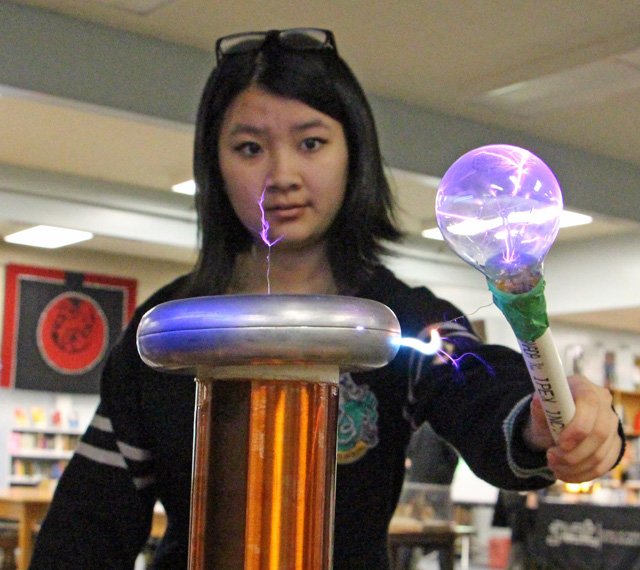
NWSS students at the 2nd annual Maker Fair this week got the chance to demonstrate – and experience – the use of technology in learning, from media arts to 3D printers, robotics, and the ‘wow factor’ of high-voltage Tesla coils…
Students demonstrate learning in multi-faceted ways…
The Second Annual Maker Fair at the New Westminster Secondary School this week was clearly an adventure in science, crafts, engineering, videography, technology and creativity.

But it was more than a gathering for hobbyists and techies.
Students at NWSS are part of a paradigm shift happening in education – with more and more opportunities for innovative, creative ways to demonstrate learning in any number of academic subjects.
Rather than relying solely on written essays and tests, students are increasingly incorporating a hands-on approach to projects through the use of technology and other tools.
That means students in Jeff Meville’s social studies class, for instance, can explore the 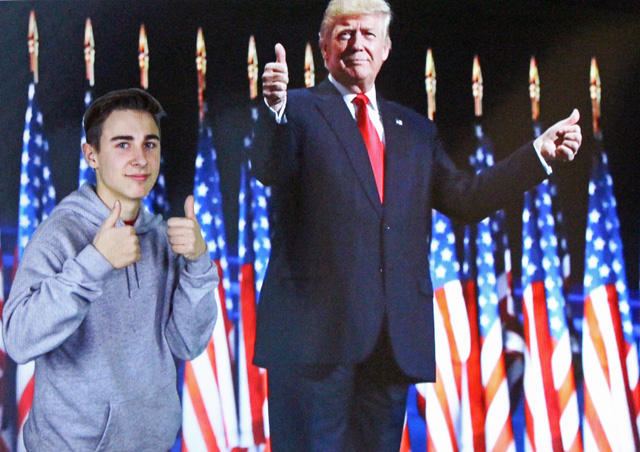 French Revolution by using the green screen, TV screen and camera in the NWSS library to change the backgrounds of photographs and videos.
French Revolution by using the green screen, TV screen and camera in the NWSS library to change the backgrounds of photographs and videos.
With a little imagination, they can situate themselves in a video of the march on Versailles or the burning of the Bastille to provide ‘live coverage’ and on-the-spot analysis of living history, Meville explained.
The digital media arts site is now a fixture in the NWSS library – or Learning Commons – and available for all students to use for a variety of projects.
Naturally, the green screen during the Maker Fair was used for more light-hearted demonstrations for visiting classes – showing students floating in outer space, participating in body building contests, or mixing it on stage with US President Donald Trump.
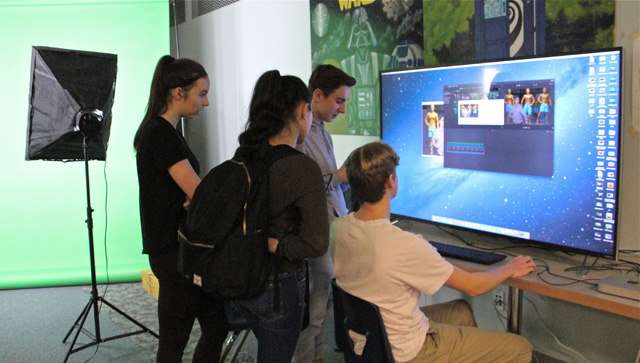
Students from science, physics, English and math classes check out the digital arts station in the NWSS Library Learning Commons during the Maker Fair…
Ideas in action…
In other instances, the “maker’ approach to learning means that, for English Language Learning students, a project on social justice can go beyond a verbal or written analysis of the environmental costs of the fashion industry.
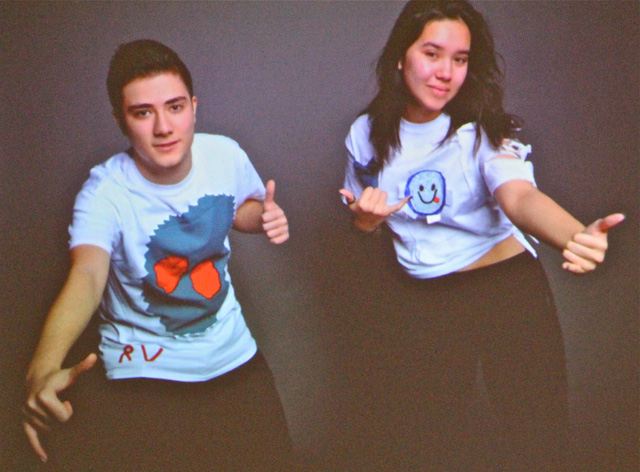
Instead, two classes of students actually demonstrated ecologically responsible ideas by designing ‘up-cycle’ clothing and making protoypes using recycled textiles.
They also developed a marketing campaign to go with their “Eco-llaboration Project” – using videographic support.
As a result, their message of diverting 9.5 million tonnes of clothing headed to landfills in North America and reducing both fresh water and energy used in the global textile industry hits home that much more powerfully.
Student-led learning..
Student Eric Callaway is so interested in emerging technologies that he’s stepped into a newly created role at NWSS as the ‘learning technologist.” That gives him time to develop his expertise with 3-D printers, videography and other tools to provide technology support for both teachers and students.

In response to a teacher request, for instance, he recently used the 3-D printer to create a three-dimensional version of the constellation of Orion that shows the relative distance and positions of its stars.
As NWSS teacher-librarian Lorena Jones noted: “The use of technology is a huge change in learning, partly reflecting the technology focus of the job market and partly the drive for more inclusive learning opportunities beyond reading and writing.”
Engineering and Technology Education teacher Val Pontier noted that technology has both built barriers (when it is not user-centred) and removed them.
He said the Maker Fair approach to learning can help bridge the gap between the theoretical and the tangible when students have the chance to build and make things. It also provides opportunities for students to work across a variety of disciplines such as science, engineering, art, craft, performance and more.
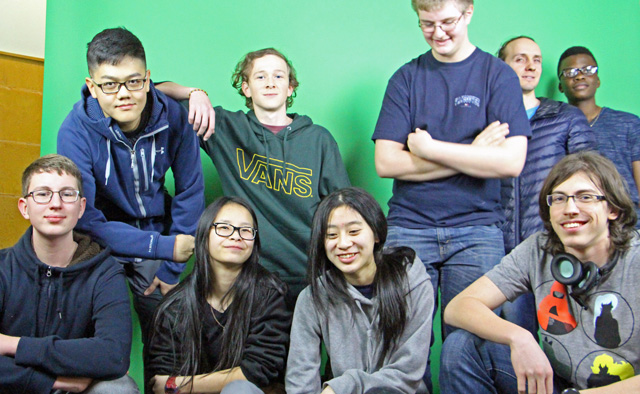
Members of the engineering club in front of the green screen at the NWSS Learning Commons: the Maker Fair is spreading the message that technology is for everyone…
The role of technology in fostering ‘deep involvement’ in education…
At NWSS, student use of technology for projects in areas like Social Studies is currently a subject of research among a group of teachers. They are asking how the use of tools such as ipads, Chromebooks, green screens and video equipment will impact student learning. The key question is whether such tools can raise the quality of student work and engagement when students are involved more deeply in the planning, design and construction of their own projects .
 The research is supported through the New Westminster Schools “Innovation Learning Grants” program encouraging innovation and creativity in the classroom to support student learning.
The research is supported through the New Westminster Schools “Innovation Learning Grants” program encouraging innovation and creativity in the classroom to support student learning.
NWSS Principal John Tyler noted that the students’ growing use of technology at NWSS “really shows how passionate they are about applying what they are learning.”
“What I’m impressed with is the range of engagement and the diversity of students involved in experiential learning.”
Tyler said it’s having an impact on many of the school’s departments – from social studies classes to the library itself, which is less and less used as a quiet place of solitary learning as it evolves into a Learning Commons.
“We have taken out our bank of desktop computers and students are using portable Chromebook (computers), which allows them to gather together, work together, and collaborate on projects.”
The Maker Fair Tuesday welcomed drop-in visitors along with visits from six high school classes, including Science 10, Physics 11, Math, and International Baccalaureate English classes.
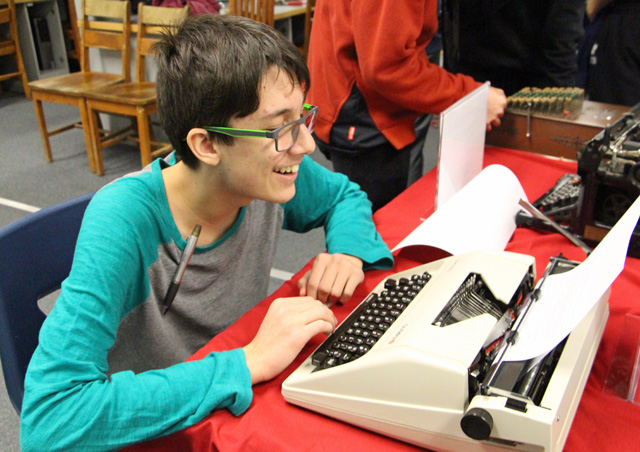
An École Glenbrook Middle School student encounters a relatively ancient typewriter on display at the Maker Fair. Two middle school students are finding out how more modern technology is being used at NWSS, and hope to help support similar use at their own school…
